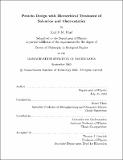Protein design with hierarchical treatment of solvation and electrostatics
Author(s)
Hanf, Karl J. M. (Karl John Mortley), 1969-
DownloadFull printable version (15.65Mb)
Other Contributors
Massachusetts Institute of Technology. Dept. of Physics.
Advisor
Brice Tidor and Alexander van Oudenaarden.
Terms of use
Metadata
Show full item recordAbstract
A detailed treatment of the electrostatic energy of biomolecules in solution is used for two applications that require consideration of large numbers of states: multiple-site titration and protein design. The continuum electrostatic model is combined with covalent, van der Waals, and non-polar energy terms, and the statistical mechanical basis for this model is reviewed. Multiple-site titration is modeled with four titratable residues of the protein barstar. A full enumeration of the titration states is used to predict pH-dependent properties of the system, and the effects of several simplifying assumptions are evaluated. The analytical continuum electrostatics (ACE) method, a computationally inexpensive approximation of the electrostatic free energy, is evaluated in the context of predicting group terms of the binding free energy. A primary source of error in the ACE prediction of atomic solvation energies is identified and ameliorated. A procedure is developed which optimizes the parameters of the ACE method in order to minimize its errors as compared to finite-difference solution of the linearized Poisson-Boltzmann equation. Parameter sets optimized on a "testing" biomolecular binding system yield reduced average errors for related biomolecular systems. Finally, a protein design method is developed which uses the dead-end elimination and A* discrete search algorithms to systematically search large numbers (10²⁴) of structures, varying the proteinsequence and the side chain conformation at all selected residues. (cont.) The method is novel in its co-optimization of binding and folding free energies, its use of three levels of increasingly detailed discrete search (sequence, fleximers, and rotamers), and its use of three hierarchical energy functions to successively screen candidate structures identified by the discrete search. Redesigning sets of three and seven residues of the protein barstar, the wild-type sequence, which is experimentally known to bind very tightly to barnase, is ranked very highly by this method (#5 out of 8000, or #89 out of 1.3 x 10⁹), unlike that of previous protein design studies. The present method chooses a structure for the wild-type sequence that is very similar to the crystal structure. Several novel sequences predicted to bind more tightly than wild-type barstar are promising candidates for synthesis.
Description
Thesis (Ph. D.)--Massachusetts Institute of Technology, Dept. of Physics, 2002. This electronic version was submitted by the student author. The certified thesis is available in the Institute Archives and Special Collections. Includes bibliographical references (p. 249-258).
Date issued
2002Department
Massachusetts Institute of Technology. Department of PhysicsPublisher
Massachusetts Institute of Technology
Keywords
Physics.